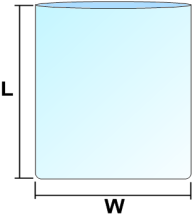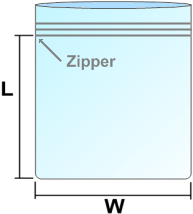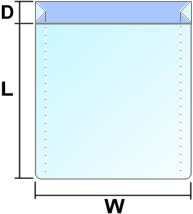In the standard format for describing a poly bag:
- the width of the bag is always taken to be the side that opens, so this is normally, but not necessarily, the shorter side.
- the width of the bag is given before the length.
- the thickness of the bag is given last and is usually expressed in 'gauge' (100 gauge = 1/1000 of an inch).
- hence the size of a bag is given as: Width (inches) x Length (inches) x Thickness (Gauge).
Flat Bags

Zip lock Bags

How thick is thick?
100 gauge - a 1/1000 of an inch.120 gauge - 'light duty' - good for protective covering.
250 gauge - 'medium duty' - good for holding light materials.
500 gauge - 'heavy duty' - where strength is required.
Metric and Imperial - a complication!
Most measurements are given in imperial (inches and gauge) but some of us prefer to use metric scales and the conversions are as follows:1" = 25.4 mm
400 gauge = 100 micron
For example: a 4"x 6" x 150 gauge bag is the same as a 102mm x 152mm x 37.5 micron bag.
Gussets - a complication!
Some bags have a gusset at the sides to help the bag open out more and enable a greater volume of items to be put in - a good example is a refuse sack. Others have a gusset at the bottom to enable a wide product to fit in - a good example is a carrier bag.
Gussted Bags

- A side gusset is expressed as a bag being x" wide opening to y" wide. For example: if a refuse sack is 16 x 25" x 39" this means it is 16" wide opening to 25" wide when the gusset is opened, with a bag length of 39"
- A bottom gusset is expressed as + x". For example: if a carrier bag is 15" x 18" + 3" then the carrier is 15" wide by 18" long with a bottom gusset of 3".
L - Length
W - Width
We very much hope this helps but if you require any help or have any questions please call 0845 200 2828 and talk to one of our experts!
No comments:
Post a Comment